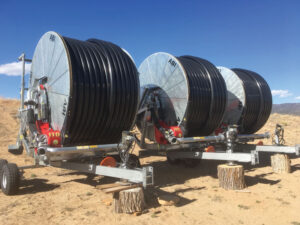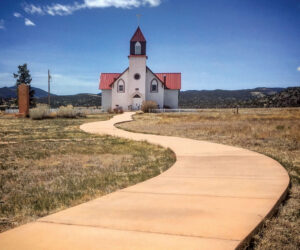By George Sibley
We’ve all heard it said: Give a person a fish, you’ve fed the person for a day. Teach the person to fish, and you’ve fed him or her for life.
So—Trump threw me a fish. At least he’s the guy who wanted his name on the checks, but our woebegone Congress had a hand in it too: a $1,200 fish thrown to everyone—except, probably, to those who most need it, the people who never make enough to file taxes, and those who fear their names and addresses falling into the hands of our army of immigrant harassers.
I was kind of offended—did the guy who signed the check think I could be bought so cheaply? I felt like the Puerto Ricans must have felt when he started tossing them rolls of paper towels. But mostly I was just disappointed: first, at the idea that the way to “stimulate” America was just to give us a fistful of dollars to spend, and second, at the total lack of imagination that represents.
I can’t help but compare Trump’s Big Deal to the 1930s, when, within a few months of taking over, the Roosevelt administration and a receptive Congress had rolled out the Public Works Administration (PWA) and the Civilian Conservation Corps (CCC), the first big elements of a “New Deal.” A few years later the Works Progress Administration (WPA) was added, and the Rural Electrification Administration (REA) and a handful of other programs.
All of these programs directly addressed a massive unemployment problem, comparable to today’s, but rather than throwing the people a fish, it put the people to fishing for a future. Repugnicans will hasten to tell me that the New Deal did not “make American great again”—did not, in other words, restore the fake prosperity of the Roaring Twenties. Instead it laid the foundation for a more widely spread prosperity, the kind that doesn’t depend on the false security of having a lot of money.
What Roosevelt’s New Deal did do—when coupled with his mandate to capital and its managers, to negotiate with labor—was finally create the American middle class. Which lasted roughly half a century, until the ongoing Reagan Revolution began to successfully undermine it, working doggedly to restore the traditional function of government: the protection of wealth and property for the few at the expense of the many.
The Repugnicans have worked hard to portray the New Deal programs as “guys leaning on shovels’”on the public dime, but those guys and gals employed under New Deal programs managed to do a lot of good work between their smoke breaks. The PWA, which primarily put contractors and their crews back to work, built much of our landmark physical infrastructure (Triborough Bridge in New York, the Overseas Highway in Florida, New York’s Lincoln Tunnel), a number of big dams including epic ones like Hoover and Grand Coulee (workforce of 8,000), water and wastewater systems, airports, and many public buildings.
The Civilian Conservation Corps (CCC), on the other hand, worked mostly with young men and boys (17-23) who were “not regularly in attendance at school, or possessing full-time employment,” many with no work experience at all; at the peak of the program, they lived in 2,900 quasi-military camps—half a million of them. It wasn’t just grunt labor; in addition to putting in a full day’s work, they were required to attend evening education classes. Their work was mostly on America’s public lands, and ran the gamut from tree planting on rape-logged land, to creation of campgrounds and picnic areas, to fighting wildfires, to restoring eroding landscapes and degraded streams, to building and collecting exhibits for local museums. A CCC crew worked on the original library and a couple other buildings still in use on the Western campus in Gunnison. A lot of both the beauty and utility of rural America today tracks back to the CCC.
The WPA also employed unskilled workers for the most part (teach’em to fish) in a vast array of projects, including 5,900 schools, 9,300 auditoriums and recreational centers, 1,000 libraries, 7,000 dormitories, 2,302 stadiums, 52 fairgrounds and rodeo grounds; 1,686 parks covering 75,152 acres, 3,185 playgrounds, 3,026 athletic fields, 805 swimming pools, 10,070 tennis courts, 138 outdoor theatres, 254 golf courses, 65 ski jumps—and more.
And it wasn’t all “bricks and mortar” infrastructure. The WPA’s Project One put writers, historians, actors, musicians and artists to work in compiling historical and cultural materials to remind us who we were, what we’d been and what we might yet be. The Federal Theater Project produced exuberant plays that so bothered the House Un-American Activities Committee that the theater project got axed. But writers and poets were paid a pittance under the Federal Writers Project to just travel around collecting stories from people, and they left us the legacy of the “Guide to America” Series, one for each state, while artists were painting thousands of local-heritage murals in post offices and other public buildings. We still treasure a set of WPA murals in Gunnison’s post office.
The New Deal program that probably most impacted the Central Colorado region was the Rural Electrification Administration (REA), facilitating the co-ops that still provide most of the region’s electricity today. This was a program that even crusty old Republican ranchers could participate in; it was no give-away, no ‘“welfare” program. It just faced the fact that no for-profit utility or municipal utility was going to lose money stringing wire through miles of farm and ranch country, so if the farmers and ranchers wanted the benefit of electricity, they would have to do it themselves, and the government would help them do that with low-interest loans and the loan of expertise for setting up cooperative systems. The “expertise” was engineers to help design a system, and crews of electricians that would descend on a community with a system just coming online and “show through doing” how to electrify houses as well as how to set poles and string wire. Most farmers and ranchers in ‘30s and ‘40s Central Colorado ended up with a lot of ‘sweat equity’ in their electric co-ops.
This New Deal program did not end in the early ‘40s, like the PWA, CCC and WPA, transmogrified into the war effort; it continued through and after the war until, by 1960, —97% of the nation’s rural inhabitants had electricity. It was expanded to include loans for rural telephone service. In the 1990s, the program was subsumed into the Agriculture Department’s Rural Utilities Service, and since the turn of the century, the RUS/REA has been working to get rural areas up to speed with the internet.
The New Deal strikes me as true “stimulus,” turning millions of people with little or no hope, in a devastated economy, into productive citizens working to make America great for everyone. As opposed to Trump’s Big Deal, where he tosses us a fish and tells us to go become consumers, for the sake of the economy he needs to get restarted in order to get reelected. It reminds me of the message from another Repugnican, in September 2001, when many of us were wondering what America, and what we as Americans, should do: that president instructed us to go shopping. Are citizens today just consumers exercising their freedom in choosing among brands and models?
After initially thinking we would just send our fish back, Maryo and I—along with some others in the community—decided instead of think of it as an invitation to develop our own local CCC/WPA program. We took the money in cash out of the bank where it had been deposited, and began looking for people who were a) contract laborers needing work, and b) probably not on Trump’s list for a check.
We weren’t looking for cheap labor; we offered $15/hour, twice the national minimum wage considered sufficient by Repugnicans. We had some personal infrastructure projects that had been on the list for a while—a couple dying trees that needed to come down, a back porch that needed sanded and stained, etc.—and we found a couple of those “lazy criminal drugdealing immigrants” that Trump warns us about, who exhausted me for a few days trying to keep the jobs prepped and supplied for work they did well and more quickly than I would have. We ended up paying them $20 an hour because they were worth it. No skin off our back; it’s just that money from Trump.
But I can’t help thinking, what if we had the kind of leadership that knew a disaster was a terrible thing to waste, and saw this as a good time to invest those trillions of dollars in actually putting a few million people to work getting a leg up on all the major infrastructure changes we have to confront eventually? I mean somebody truly creative and generous in the art of the Deal? A new New Deal? That’d be a great start on making America great again.
George Sibley lives in Gunnison, and looks for rare and endangered species, such as true Republicans. george@gard-sibley.org
Down on the Ground is sponsored by Tom Arnot and Rae Pederson.


